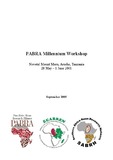| dc.description.abstract | The common bean is the principal grain legume grown by small-scale, resource-poor farmers for food
and sale in many countries in sub-Saharan Africa. However, its productivity is severely constrained by
many biotic and abiotic constraints, resulting in low production despite rising demand. The International
Center for Tropical Agriculture (CIAT), in partnership with national programmes, regional networks,
and NGOs, has released several improved bean varieties in the last decade. However, most of these
varieties originated from the CIAT breeding programme at its global headquarters in Cali, Colombia. To
strengthen the capacity of bean researchers in Africa to respond better to the changing needs of farmers
and consumers, the Pan African Bean Research Alliance (PABRA), consisting of CIAT-Africa, the East
and Central Africa Bean Research Network (ECABREN), and the Southern Africa Bean Research
Network (SABRN), has developed a collaborative strategic plan for breeding high-yielding bean varieties
with improved tolerance to major biotic and abiotic stresses, which also meet requirements for domestic,
regional, and international markets. Following participatory approaches, breeding programmes for the
seven most important market classes have been developed and are being implemented by collaborating
NARS, selected on the basis of the importance of a particular market class in their country. Test sites
were selected to represent the major bean-growing environments and constraints for each market class.
The main priorities for the breeding programmes are (1) yield improvement, (2) identification,
characterisation, and utilisation of sources of resistance to major biotic and abiotic constraints, (3)
assessment of advanced lines for productivity in intercropped and sole cropping systems, and (4) cooking
and nutritional quality. | en |

